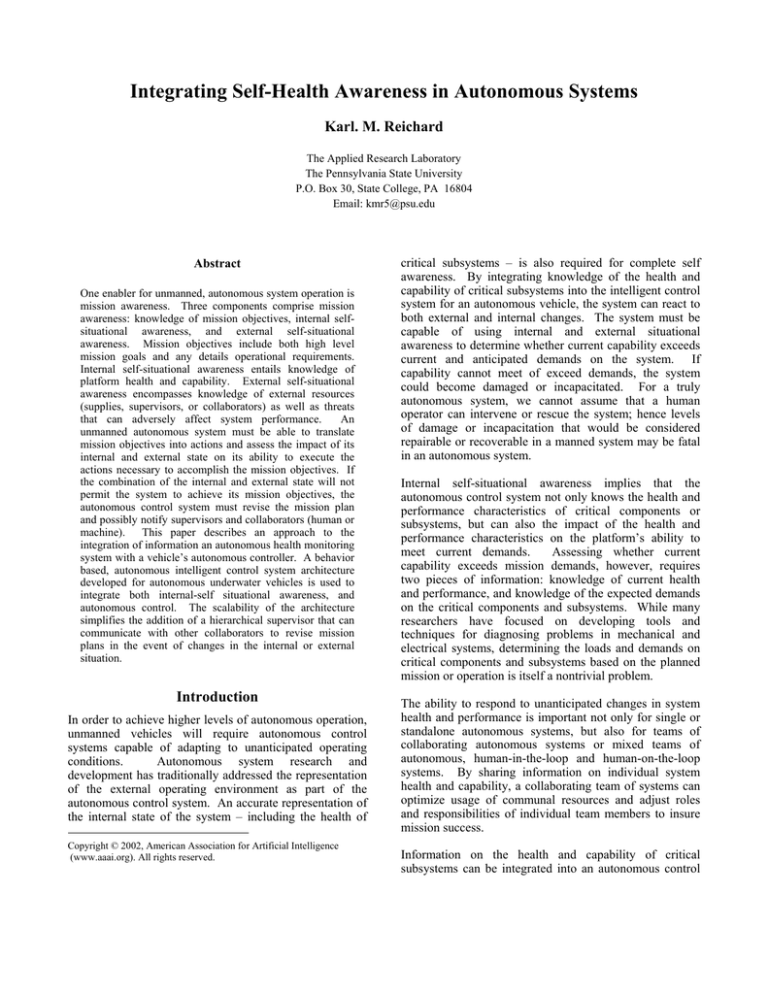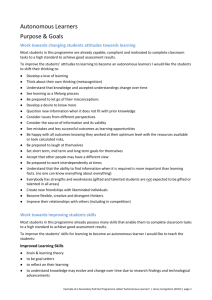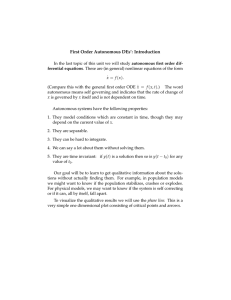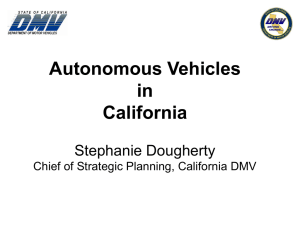
Integrating Self-Health Awareness in Autonomous Systems
Karl. M. Reichard
The Applied Research Laboratory
The Pennsylvania State University
P.O. Box 30, State College, PA 16804
Email: kmr5@psu.edu
Abstract
One enabler for unmanned, autonomous system operation is
mission awareness. Three components comprise mission
awareness: knowledge of mission objectives, internal selfsituational awareness, and external self-situational
awareness. Mission objectives include both high level
mission goals and any details operational requirements.
Internal self-situational awareness entails knowledge of
platform health and capability. External self-situational
awareness encompasses knowledge of external resources
(supplies, supervisors, or collaborators) as well as threats
that can adversely affect system performance.
An
unmanned autonomous system must be able to translate
mission objectives into actions and assess the impact of its
internal and external state on its ability to execute the
actions necessary to accomplish the mission objectives. If
the combination of the internal and external state will not
permit the system to achieve its mission objectives, the
autonomous control system must revise the mission plan
and possibly notify supervisors and collaborators (human or
machine). This paper describes an approach to the
integration of information an autonomous health monitoring
system with a vehicle’s autonomous controller. A behavior
based, autonomous intelligent control system architecture
developed for autonomous underwater vehicles is used to
integrate both internal-self situational awareness, and
autonomous control. The scalability of the architecture
simplifies the addition of a hierarchical supervisor that can
communicate with other collaborators to revise mission
plans in the event of changes in the internal or external
situation.
Introduction
In order to achieve higher levels of autonomous operation,
unmanned vehicles will require autonomous control
systems capable of adapting to unanticipated operating
conditions.
Autonomous system research and
development has traditionally addressed the representation
of the external operating environment as part of the
autonomous control system. An accurate representation of
the internal state of the system – including the health of
Copyright © 2002, American Association for Artificial Intelligence
(www.aaai.org). All rights reserved.
critical subsystems – is also required for complete self
awareness. By integrating knowledge of the health and
capability of critical subsystems into the intelligent control
system for an autonomous vehicle, the system can react to
both external and internal changes. The system must be
capable of using internal and external situational
awareness to determine whether current capability exceeds
current and anticipated demands on the system. If
capability cannot meet of exceed demands, the system
could become damaged or incapacitated. For a truly
autonomous system, we cannot assume that a human
operator can intervene or rescue the system; hence levels
of damage or incapacitation that would be considered
repairable or recoverable in a manned system may be fatal
in an autonomous system.
Internal self-situational awareness implies that the
autonomous control system not only knows the health and
performance characteristics of critical components or
subsystems, but can also the impact of the health and
performance characteristics on the platform’s ability to
meet current demands.
Assessing whether current
capability exceeds mission demands, however, requires
two pieces of information: knowledge of current health
and performance, and knowledge of the expected demands
on the critical components and subsystems. While many
researchers have focused on developing tools and
techniques for diagnosing problems in mechanical and
electrical systems, determining the loads and demands on
critical components and subsystems based on the planned
mission or operation is itself a nontrivial problem.
The ability to respond to unanticipated changes in system
health and performance is important not only for single or
standalone autonomous systems, but also for teams of
collaborating autonomous systems or mixed teams of
autonomous, human-in-the-loop and human-on-the-loop
systems. By sharing information on individual system
health and capability, a collaborating team of systems can
optimize usage of communal resources and adjust roles
and responsibilities of individual team members to insure
mission success.
Information on the health and capability of critical
subsystems can be integrated into an autonomous control
system in a number of ways. This paper describes an
approach to integrating health monitoring for critical
components and subsystems into an autonomous control
system wherein the health monitoring system functions as
an autonomous system which collaborates with the
platform control system. The integration of the health
information into the autonomous control system is
demonstrated using a behavior-based autonomous
intelligent control system architecture used by the Applied
Research Laboratory in autonomous underwater vehicle
applications.
The application of integrated health
monitoring and autonomous control is demonstrated in a
simulation of two autonomous underwater vehicles
executing a joint search mission. The application of
integrated health monitoring and control is also described
for an autonomous ground vehicle platform under
development at the Applied Research Laboratory.
System Health Monitoring for Self-awareness
Automated system health monitoring involves the
application of sensors, analysis, data fusion and automated
reasoning to estimate the health and track the degradation
of a system. A top-level view of system health monitoring
is shown in Figure 1. Demands and loads are driven by
mission requirements at the platform level and propagate
down to the material level.
Simultaneously, the
degradation, and ultimately the failure, of components and
subsystems starts at the material level and propagates up to
affect operational capability. The monitoring system must
detect and isolate component degradation and impending
subsystem failure then generate appropriate alerts to
autonomous control systems, operators, asset managers,
and maintainers [1].
Figure 1 also shows the application of sensing, modeling
and reasoning to system health monitoring. Data from
sensors are processed and fused with other commensurate
or non-commensurate sensor data. The detected state of
the system is compared to historical data or system models
to predict the remaining useful life of the component based
on the observed evolution of the fault. Automated
reasoning techniques are applied to determine the impact
of the identified system state and remaining capability on
the current or planned mission and convert that knowledge
into useful information for the autonomous control system,
operator or other information customers.
The costs associated with sensors and data acquisition
systems are small compared to the cost of the platforms
and payloads. Another key monitoring system component,
the communication bandwidth required to transport data
and information, however, can be expensive – both
literally, in the cost of communications system
requirements, and figuratively, in terms of opportunity
costs if payload sensor communication bandwidth must be
sacrificed for monitoring sensor data.
Hence, the
monitoring system must employ smart sensors and operate
with its own autonomy to provide the platform
autonomous intelligent control system or mission
supervisor with high level information as opposed to raw
sensor data. An architecture for monitoring system health
cts
ffe
E
&
res
ilu
Fa
PLANT / PLATFORM
SYSTEM
. . .
SUBSYSTEM
COMPONENT
KB
ELEMENT
REASONING
-80
( C a s e B r e a th
24 85 H
3 0 7 7 .5
2 7 3 7 .5
2450 H
28 8
R ock a boutY
(B a s e a n d C a
1 900 H z
(Z tr a n s c a s
B a s e r o c ki n g m o t io n )
3 5 25 H z
-60
B a s e ro c k )
665 H z
101 H z
-40
1232 H z
MATERIAL
(C a s e /S u p p r t R
A v g I m a g x(H
y) (d b r e 1 V
-20
(B a s e & C a s e R o c k a b
0
X d ir
-1 0 0
Interstitial Enveloping for Run 14
All Accelerometers
Y d ir
-1 2 0
1
Z d ir
A cc eler omet er 2
-1 4 0
A cc eler omet er 3
0
A cc eler omet er 4
0.1
50 0
100 0
1500
2000
25 00
3000
3500
4 000
A cc eler omet er 5
F r e q ( H z , in 2 .5 H z b a n d s )
S tart 3X Load
0.01
MODELING
0.001
0. 0001
0. 00001
3/ 19/ 98 12: 00 3/ 19/98 14: 24 3/ 19/98 16:48 3/19/98 19:12 3/19/ 98 21:36 3/ 20/98 0:00
3/ 20/98 2:24
3/20/ 98 4:48
3/20/ 98 7: 12
Date/ Ti me
3/20/ 98 9: 36
s
ad
Lo
&
ds
an
m
De
SENSING
Figure 1 Demands and loads flow down from the platform level to the material level;
degradation and failure propagate from the material level to the platform level.
autonomous control system also be capable of performing
the processing, fusion, and reasoning tasks associated with
determining the health and capabilities of the subsystems
from the sensor data [2]. Depending on the type of sensor,
these signals may be sampled at 10’s or 100’s of kHz in
order to provide early indicators of system degradation.
While parameters such as temperature change rather
slowly and lag changes in system health, parameters such
as vibration can provide earlier indications of component
degradation.
Detecting early indicators of a change in
system health, however, typically requires extracting high
features associated with high frequency components of the
measured vibration signals. The use of intelligent sensor
nodes and a hierarchical architecture reduces 100’s of kilo
bytes of raw data to 10’s of bytes of high level health
information, a 104 reduction in bandwidth requirements.
to provide self-situational awareness is shown in Figure 2.
The health monitoring system architecture uses a
hierarchical organization of distributed nodes to process
raw data and assess health and condition at the
components, subsystem and system levels.
This
architecture can be implemented using a combination of
physical (hardware and software) and virtual (software
only) processing nodes.
At the lowest level, sensors monitor signals that provide
indicators of system health and performance. At the next
level in the health monitoring system data from multiple
sensors associated with a particular subsystem are fused to
improve detection of faults and reduce false alarms. At the
next higher level, health information from multiple
subsystems is fused to assess the health and condition of
entire systems. Information can flow both ways and
laterally between subsystem or system monitoring nodes to
permit health assessment in the context of subsystem and
system interactions. At the highest level, knowledge of
system health is available for mission management and as
an input to the autonomous control system.
Autonomous Intelligent Control Architecture
A behavior-based, autonomous intelligent control
architecture is used to integrate internal and external selfsituational awareness and execute the desired mission. In
fact, the same architecture is used within the health
monitoring subsystem to provide internal and external selfsituational awareness. The use of a common autonomous
system architecture eases the task of integrating system
monitoring with control to provide autonomous vehicle
management.
The hierarchical health monitoring system architecture
shown in Figure 2 has two advantages: it reduces the
bandwidth required to get health information to the user
(human or autonomous control system) by processing the
raw sensor data, and it eliminates the requirement that the
Mission
Management
Autonomous
Control
Knowledge
System
Monitor
Subsystem
Monitor
Intelligent
Sensor
Node
Data
Subsystem
Monitor
Intelligent
Sensor
Node
Drivetrain
Suspension
Drive Motors
Intelligent
Sensor
Node
Subsystem
Monitor
Intelligent
Sensor
Node
Sensors
Intelligent
Sensor
Node
Sensors
Science
Sensors
Figure 2 Hierarchical architecture for system health monitoring.
Intelligent
Sensor
Node
Batteries
Solar Cells
RTG
The Applied Research Laboratory has developed,
demonstrated and deployed systems based on an
autonomous intelligent control system (AICS) architecture
in a number of applications [3-4]. The core of the AICS
architecture, depicted in Figure 3, consists of a perception
module and a response module. The perception module
processes sensor information, commands, and messages to
provide situational awareness for the controller.
Depending on the source of the inputs to the perception
module, the “situational awareness” may be internal, selfsituational awareness, external situational awareness, or a
combination of the two.
The perception module
determines which behaviors should be activated to respond
to the current situation. The response module accepts the
behavior recommendations of the perception module and
considers the necessary actions within the context of the
current mission plan.
Messages
Perception
Response
Sensor Data
Fusion
Operational
Assessment
Inferencing
Planning
Situation
Awareness
Plan Execution
Output Interface
•
•
•
Smart
Sensorn
Input Interface
INTELLIGENT CONTROLLER
Smart
Sensor 1
Output Messages
Figure 4 Autonomous Intelligent Control System
architecture.
the capability of critical components or subsystems. The
latter approach reduces the bandwidth required for the
transport of health-related information which can become
especially important in multi-vehicle systems where offplatform communication bandwidth may be limited. The
latter approach also decouples the design of the health
monitoring system from the control system design and
reduces the computational burden on the control system if
extensive processing is required to extract system health
from the sensor data.
One of the strengths of the AICS is the flexibility afforded
the system through messages that allow one controller to
communicate with another. Through these messages,
multiple controllers, configured in parallel or in a
hierarchy, can collaborate and effect changes in the overall
mission plan. The application of the AICS architecture for
internal situational awareness, external situational
awareness and mission supervision is depicted in Figure 4.
Three control blocks are arranged in a hierarchical
architecture so the mission supervisor accepts inputs in the
form of messages from subcontrollers providing internal
and external situational awareness. The mission supervisor
can communicate with digital or analog control systems for
a specific platform subsystem to carry out specific actions
or may communicate with another autonomous controller
for particular subsystems (such as an autonomous
propulsion system).
Sensor Data
(Health)
The perception module creates an internal representation
of the world external to the AIC that is relevant to its
mission using the processed input data and messages from
other AICs or human operators/collaborators.
This
representation constitutes the AIC’s “worldview” and
serves as the basis for the generation of operational
reactions through the response module. It is constructed
from a finite, fixed collection of “representational classes”
(RCs) created by the designers to specify the types of
things the perception module can recognize. For example,
data from target-acquisition sonar systems in underwater
systems would be used by the perception module to build
tracks on objects being detected; these tracks would be
instances of an RC with a descriptive name, such as
“Track.” In order to accommodate the integration of
health information, the control system should be designed
to recognize health as a representational class.
Integrating Health Monitoring Into
Autonomous Systems
Designers have a number of choices when integrating
health information into an autonomous system. Health
information can be integrated in the form of low-level
sensor data by providing data from sensors mounted on
critical components or subsystems directly into the
autonomous control system. At the other extreme, health
information can be integrated as high level information on
IVHM
Supervisor
PERCEPTION
RESPONSE
Internal Health/Status
Messages
Mission
Intelligent Supervisor
PERCEPTION
Sensor Data
(Environment)
Mission Plan
RESPONSE
External
Situation Supervisor
PERCEPTION
RESPONSE
External
Situation/Status
Messages
Figure 3 Application of multiple AICS for
integrated system monitoring and control.
The architecture shown in Figure 4 has been demonstrated
in simulation in a collaborative exercise between two
autonomous unmanned underwater vehicles. The two
vehicles were tasked to perform a collaborative
surveillance mission. When the internal health supervisor
for one vehicle detects that the power subsystem is loosing
capacity, its mission supervisor sends a message to the
supervisor for the other platform. The respective mission
supervisors reallocate mission responsibility for each
platform to still accomplish the overall mission despite
degraded capability in one platform.
Figure 5 shows the tracks of the two vehicles. The vehicle
on the right experiences the power system fault and the
vehicle supervisor onboard the other vehicle (the vehicle
on the left in Figure 5) adapts it’s mission to cover a larger
search area and make up for the degraded capability of the
other vehicle.
Figure 5 Simulated search tracks for two
collaborating vehicles with shared health
A key issue in such multi-vehicle systems is the level of
communication between individual vehicles. Although
many possible configurations exist, there are three
architectures that are worth considering:
• No direct communication
• All communication routed through a supervisor
• Fully integrated communication among peers
In the first communication architecture, there is no direct
communication between individual vehicles. The only
way one vehicle knows the health and capability of the
other is by interference through observing the other
vehicle’s behavior. This fails to take advantage of selfsituational awareness capability on the other vehicle since
each vehicle is forced to assess it’s health and performance
as well as the health and performance of the other vehicles.
In the second communication architecture, each vehicle
can communicate with a designated supervisor but not
directly with other peers. This insures that there is always
a supervisor with knowledge of the health of all vehicles.
The supervisor is therefore responsible for changing the
overall mission or roles of the individual members based
on the health and capability of all of the assets. One
disadvantage of this communication scheme is a lack of
robustness in the event of damage or loss of the supervisor.
The third option can be implemented in a broadcast
scheme where each vehicle publishes updated information
on it’s health and capability to the other vehicles or in a
scheme where individual vehicles can request the health
and performance information for all or a subset of the
other vehicles. This method of communication provides
the greatest flexibility since the other options described
above can actually be implemented under this
configuration. It allows for a supervisory-type structure
with a fixed supervisor but also allows the possibility that
another vehicle can assume the supervisor role in the event
of damage to the existing supervisor. This communication
scheme also permits more swarm-like tactics where each
vehicle makes it’s own decisions based on knowledge of
the health and capabilities of it’s neighbors. In the absence
of a central supervisory or planning entity, the behavior of
the collection of vehicles emerges from the combined
efforts of the collective.
A complete dissertation on the advantages and
disadvantages of centralized versus decentralized
communications within a swarm or team of autonomous
vehicles is beyond the scope of this paper. It is clear,
however, that sharing of raw sensor data related to the
health and performance of an individual platform is
undesirable. The use of embedded health monitoring
systems, however, condenses that information into very
compact messages that can be accommodated within
existing communication bandwidth restrictions. The use of
the intelligent control architecture described above
facilitates sharing information from one platform to
another through the inclusion of messages between
controllers.
Because the controllers can be peers
(operating at the same functional level within controllers
on different vehicles) or hierarchical (vehicle to supervisor
or vice versa) the autonomous intelligent control
architecture can be applied in any of the three
communication architectures.
Autonomous System Demonstration Platform
ARL has constructed a small ground vehicle platform for
testing and demonstrating autonomy concepts.
The
platform, shown in Figure 6, is built on the chassis from a
radio-controlled, off-road truck. The testbed was designed
to accommodate a flexible configuration of sensors for a
variety of applications. The system block diagram is
shown in Figure 7. The current configuration includes a
digital GPS, a combination compass and magnetometer,
and an ultrasonic range finder for navigation. An IR
camera and the ultrasonic rangefinder are mounted on a
pan and tilt to simulate mission specific sensors. A rear
pan and tilt with a second IR camera and range finder are
planned for the rear of the vehicle.
The autonomy testbed described in Figure 6 and Figure 7
is being used to test and demonstrate the concepts
described in this paper. In particular, the vehicle includes
an integrated vehicle health monitoring system that
monitors battery health monitoring. The health monitoring
system provides the autonomous intelligent control system
with an assessment of the battery state of charge and state
of health. The state of charge determines the remaining
system capability during the current mission or charge
cycle. The battery state of health provides a prognostic
capability and determines the capacity during the next and
successive missions or charge cycles.
The health monitoring system provides the battery health
information to the autonomous intelligent control system
via high-level messages. The autonomous intelligent
control system uses the information to adjust the mission
plan to insure that the system returns to a location with
battery recharging capability. The health information is
also shared with collaborating autonomous systems to
adjust individual mission plans to complete as much of the
higher-level mission as possible with the reduced
capability of an individual platform.
a variety of platforms and applications. The integration of
these technologies provides an enabling capability for
autonomous systems and has been demonstrated in
simulations of collaborating autonomous underwater
vehicles and using an autonomous ground vehicle testbed.
Acknowledgements
This paper is based upon work supported by NASA under
the Engineering for Complex Systems Program –
Autonomous Propulsion Systems Technology Subprogram
(Grant No. NAG3-2778).
References
[1] K. M. Reichard, C. S. Byington, N. J. Nadianos, G. W.
Nickerson, “Expanding the Foundation for Prognostic Health
Management in Complex Mechanical Systems”, Proceedings of
the Symposium on Condition Based Maintenance for Highly
Engineered Systems, Pisa, Italy, September, 2000.
[2] K. M. Reichard and E. C. Crow, “Self-Awareness,
Monitoring and Diagnosis for Autonomous Vehicle Operations,”
Proceedings of AUVSI Unmanned Systems 2002, Orlando, FL,
2002.
Figure 6 Photograph of ARL/PSU ground vehicle
autonomy testbed.
IR
Video
USB 802.11 LAN
Wireless Communications
Serial to USB
Range
Mission Sensors
Range
Serial to USB
DGPS
Serial to USB
Compas
Serial to USB
Navigation
Battery
Health Sensors
USB to Serial
Propulsion
Effectors
USB Hub
PIC
Driving Servos
TBD
Embedded
PC
Figure 7 Functional block diagram of ARL/PSU
ground vehicle autonomy testbed.
Conclusion
In order to achieve high levels of safety and mitigate
mission risk, unmanned systems will require selfsituational awareness and autonomous decision and
response capability to respond to unplanned events, system
degradation and failure. The Applied Research Laboratory
has developed and demonstrated both system health
monitoring and autonomous intelligent control systems for
[3] R. Kumar and J. A. Stover, “A Behavior-Based Intelligent
Control Architecture with Application to Coordination of
Multiple Underwater Vehicles,” IEEE Transactions on Systems,
Man, and Cybernetics, Vol. 30, Number 6, pp 767-784, 2000.
[4] J. A. Stover, D.L. Hall, and R.E. Gibson, “A Fuzzy Logic
Architecture for Autonomous Multisensor Data Fusion,” IEEE
Transactions on Industrial Electronics, Vol. 43, No. 3, pp. 403410, 1996.




